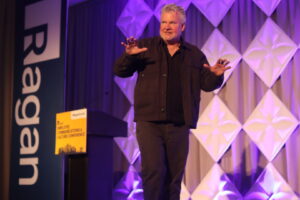4 tips for success as comms pros reimagine the conference experience
By leaning into the strengths of virtual conferences, Capital One’s corporate communications and tech events teams successfully united thousands of tech associates in a new format.

The pandemic has taken a toll on nearly every type of business, but few more so than the conference industry. That’s why when things started looking dire at the beginning of 2020, Capital One’s corporate communications team, in partnership with the tech events team, started making some tough decisions.
“I remember having conversations with my colleagues, thinking that we’ll be back in the office in two or four weeks,” says Jeffrey Cooke, corporate communications manager, tech events program. “And pretty early on we decided to make the call that we just need to commit to virtual.”
But as anyone can tell you, virtual conferences generally fall a bit flat. And with the Software Engineering Conference (SECON)—Capital One’s largest internal conference for tech associates—coming up, the stakes were high. Thanks to the ingenuity of the team, not only was the event an overwhelming success, but it was also given an honorable mention by the coveted Ragan Awards.
Here’s the behind-the-scenes story of how the team pulled it off, along with a few lessons and tips to share with those facing similar challenges:
1. Lean into the strengths of virtual conferences.
Tip: Ask your attendees what they would find most beneficial in a virtual conference.
The team started by looking around at already available conference platforms that many of us have seen before. But most were expensive, hard to adapt, and clunky to use. Instead, the team went with a bold solution: designing its own conference program from the ground up. But that brought up other challenges—namely, what exactly would the conference look like?
“We learned that we really needed to rethink everything,” says Cooke. “It’s not as simple as picking up the components from in-person events and moving them into a virtual environment.”
To gain further insight, the team spoke with associates to see what they were actually looking to get out of the conference. They learned that networking—a conference staple—was a lower priority in virtual settings. And because the conference was internally-focused, associates noted they could easily connect over other channels like Slack. Instead, what they were really interested in was something perfectly suited to a virtual platform: easily-accessible content.
So that’s what the team focused on delivering within its new virtual conference platform. The team designed a smooth and streamlined interface that allowed people to choose from over 125 breakout sessions and demos along five learning tracks: AWS, cloud, data, machine learning, and software engineering. It also featured panel discussions with senior leadership, demos where associates could show off recent work, and even trivia events.
2. Focus on access.
Tip: Leverage existing personal development days to schedule internal events.
In normal times, SECON maxes out at around 2,200 associates who must arrange work schedules with teams and leadership so they can travel to the event. This year, Capital One tried a new approach: scheduling newly-launched “Invest in Yourself Days” during the conference to give all tech associates the freedom to participate in the conference.
“By slating SECON during Invest in Yourself Days, associates were able to engage more fully without having the need to multitask,” says Jackie Foreman, corporate communications manager (Tech).
One of the reasons engagement was so high was that the virtual conference allowed all associates to participate equally.
“For us, a company that has associates all across the U.S., and in some cases internationally, there’s often geography bias,” says Cooke. “But with the online format, it creates equity and access for all of our associates, which was reflected in the feedback that we heard.”
Making a mobile-friendly format was also very important to the team, so that associates could choose where they wanted to be while participating.
With so many more people able to participate, SECON saw record-setting levels of engagement. Attendance increased by 200%, with over 1.5 million website engagements measured by clicks, page refreshes, and more. Almost 8,500 virtual attendees tuned in to the opening keynote featuring Chief Information Officer Rob Alexander.
3. Celebrate company achievements.
Tip: Use conferences to mark milestones and build employee morale.
With record attendance, the event organizers were quick on their feet to leverage this moment to celebrate a company milestone: Capital One became the first U.S. bank to go all in on Cloud data, something that has been eight years in the making. This led to real-time engagement, boosting overall employee morale and chatter within the company.
4. Redirect cost savings.
Tip: Use savings to create surprise-and-delight experiences for attendees.
Moving to an all-digital conference produced significant cost savings over an in-person conference, and the team redirected some of this money in other ways to make the experience better for attendees. For example, it surprised all associates with a Starbucks gift card and created a virtual swag booth where associates could order their own t-shirts, rather than running the risk of certain sizes running out of stock.
“We saw over 6,000 shirts ordered. I think anyone loves a free shirt, but I would say technologists maybe even a little more,” Cooke jokes.
After the conference, the results came rolling in: Everyone loved it. So much so, in fact, that Capital One will be reusing the SECON platform for other internal conferences, too.
Moving forward, SECON will continue to be a digital-first event—but for Cooke, the biggest win of all was the team’s ability to adapt and create something completely new and better than before.
“I think COVID has impacted us in many different ways. I’m just really proud of what our team was able to produce under really challenging circumstances.”
Sukhi Sahni is the head of corporate communications for U.S. card and retail bank divisions at Capital One and is responsible for telling integrated stories of impact driven by innovative, customer centric solutions.
Jeffrey Cooke is a manager on the corporate communications team supporting the Technology organization at Capital One. His work includes event production strategy and execution, integrated storytelling and marketing, executive communications, employee engagement and project management.
Jackie Foreman is a manager on the corporate communications team supporting the Technology organization at Capital One. Her work includes integrated communications strategy development, executive communications, employee engagement, narrative development, and media and influencer relations.






